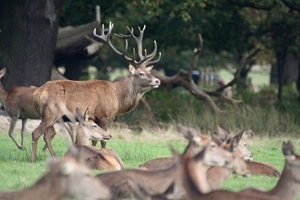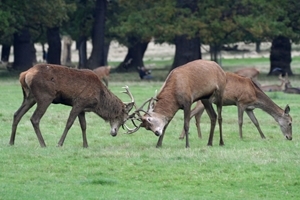Red deer
 The weather has certainly changed now and it finally feels like the seasons have too, at last! I have spent too many days recently thinking that the weather felt more like spring than autumn, but now the colder climate has come in and triggered my annual pilgrimage to my ‘secret’ part of the New Forest in Hampshire, away from all the visitors, to watch the rut from afar, where I have been going since I was carried in arms.
The weather has certainly changed now and it finally feels like the seasons have too, at last! I have spent too many days recently thinking that the weather felt more like spring than autumn, but now the colder climate has come in and triggered my annual pilgrimage to my ‘secret’ part of the New Forest in Hampshire, away from all the visitors, to watch the rut from afar, where I have been going since I was carried in arms.
So, you might have guessed it: this month’s species will be a deer, specifically the red deer (Cervus elaphus).
There are six species of deer in the UK, but only the red and roe deer are native. The red deer migrated to Britain from mainland Europe around 11,000 years ago and were extensively used by Mesolithic man as a source of food, skins and tools (bones and antlers). However, the development of agriculture by Neolithic man cleared swathes of forest to make way for fields, and this loss of forest encouraged the decline of red deer populations, which became confined to the Scottish Highlands, southwest England and a few other small, scattered populations.
Continued hunting and loss of woodland has meant that the red deer were rare by the end of the 18th century. However, numbers have grown considerably over the past 100 years, thanks to habitat changes and releases or escapes from deer parks. Red deer numbers have now continued to grow, and they can be found in woodland and forest habitats in England and southern Scotland. Woodland habitat is their preference, but red deer can also adapt to open moor and hills. Native stocks are common in the Scottish Highlands, Dumfriesshire, Lake District, East Anglia and the southwest of England.
Red deer are Britain’s largest land mammal, with mature stags (males) standing up to four feet tall at the shoulder and weighing up to 200kg. They are a breathtaking sight, especially at this time of year when they are crashing about in the rut (breeding season).
Red deer have red-brown fur with a cream rump, and the stags develop a large set of antlers that grow with age. Starting with just two points, the antlers steadily develop more branches, reaching up to 16 in most cases. These antlers are shed and regrown every year. Females (hinds) lack antlers and are more lightly built than stags.
 The rut spans from the end of September to November, when the stags return to the hind’s home range and compete for them by engaging in displays of dominance including parallel walking, roaring, grunting, chasing and fighting. It is not just for show – injury and death can be the result. If another stag is undeterred, the two will fight, locking antlers and pushing and twisting until the weaker of the two flees. Whichever one reigns high becomes the dominant stag and ensures exclusive mating with all the hinds in that group.
The rut spans from the end of September to November, when the stags return to the hind’s home range and compete for them by engaging in displays of dominance including parallel walking, roaring, grunting, chasing and fighting. It is not just for show – injury and death can be the result. If another stag is undeterred, the two will fight, locking antlers and pushing and twisting until the weaker of the two flees. Whichever one reigns high becomes the dominant stag and ensures exclusive mating with all the hinds in that group.
After the rut is over, the hinds normally give birth to a single youngster, known as a calf, in late spring or early summer. The calves are born with their own camouflage from predators, a spotted coat, which they have for a short time, just the first few months of their life while they are left hidden in vegetation and only visited by their mother for short periods to suckle.
Outside the rut, males and females don’t generally mix and live separately. In open habitat, hinds and their young will gather in large herds, while stags live in loose bachelor groups. Deer are less social in woodland, typically living in smaller groups comprising a female and her young.
So, what do they eat?
Grasses are the primary food of red deer, but they will eat a range of plants, including tree shoots, sedges and rushes, herbs and shrubs. Their varied diet can come into conflict with woodland managers and farmers due to economic damage of trees and crops. Conversely, many country and forest estates can gain substantial revenue from stalking and/or venison production. Whether in conflict or used as a resource, as with many species, red deer populations require careful management to maintain health and quality and ensure a sustainable balance with their environment due to the absence of any natural predators.
I realise that the rut is nearly over, but if you are out in the woods or moorland where you know red deer to be, please keep your distance and your dog on a lead. This is not only for your own safety, but also not to disturb the rut, which is a very important time of year. It is best to visit a deer park, as the deer are more tolerant and used to humans’ presence, even though they will still avoid being in proximity to us. However, even if you are in a deer park, it is still advisable to keep at least 100m away from rutting stags. Stags are very pumped up with testosterone in the rut and no photograph is worth getting skewered by an antler!
Megan Lock
Advisory
Image credit: Megan Lock